Nothing beats a rainy day on the rocky shorelines of Vancouver Island. With a good coffee, a rain-jacket, and a pair of rubber boots, the day is yours to enjoy. While many of us may think of gulls and sea stars when we think of the beach, to me, no trip to the ocean is complete without the comically obnoxious (although very endearing) sounds, of a parcel of Black Oystercatchers (also known as a stew of them, if you prefer).
The Black Oystercatcher (Haematopus bachmani) is a roughly crow sized shore bird with tons of character. Thanks to birds banding programs, we know that these peppy birds commonly reach up to 15 years in age (Johnson 2010). Visually, they are easily distinguishable, as their orange bill, yellow eyes, and pink legs have a strong contrast against the rest of their black bodies. They are also easily distinguished by their call, as they seem to be yelling at each other all the time, and then at you, if you happen to get too close and they fly away.
Telling apart male and female Black Oystercatchers can prove difficult, as male and females have identical plumage and have very similar size. To date, the only two morphological ways to distinguish between the two are to either catch a pair and look closely for slight size differences in body parts, or to look for eye flecks, which are more prominent in females versus males. (Guzzetti et al. 2008).
The Black Oystercatcher is a part of the Haematopus genus, meaning “blood-foot” in latin (Jobling 2010). Worldwide, there are 10 other species of Haematopus (Guzzetti et al. 2008), some of which have feet that are more red, explaining the morbid family name. On an odd note, before they were commonly called Oystercatchers, the common name for all these birds, except the American Oystercatcher, was “Sea-pie.” An ornithologist named William Yarrell thought this was dumb, and in 1843 he established Oystercatcher as the preferred term (Jobling 2010). It should be noted, that it would have been fun to say “a stew of sea-pies.”
The distribution of the Black Oystercatcher ranges from the Aleutian Islands in Alaska, down to the outer Baja Peninsula, Mexico, in the south (Johnson 2010). Interestingly, Black Oystercatchers vary slightly in color along this range, as north of Oregon they are entirely black, while south of Oregon the birds show browner abdomens and an increasing amount of white feathers throughout their plumage (Audubon n.d.).
As their name suggests, the Black Oystercatcher eats only black oysters. They can be spotted chasing them up and down the beach, and are considered lucky if they catch one. Just kidding. Oddly, the Black Oystercatcher eats almost anything but oysters. Their diet consists mainly of different varieties of mussels and limpets, however, they are known to eat chitons, whelks, sea urchins, crabs, barnacles, clams, cockles, polychaetes, herring roe, and isopods . They forage during low tide and rest at high tide, as this coincides with the best opportunity to access their prey (Bergman et al. 2013).
When feeding on mussels, the bird employs an interesting strategy of foraging in the wave zone, as mussels that are being splashed by waves will open more frequently (Seattle Audubon Society n.d.). When feeding on mussels, the bird will typically remove the mussel from its shell by quickly sliding its bill inside the open shell and cutting the adductor muscles, and then cleaning out the insides. The alternative, and more labour intensive strategy, is to simply hammer on the mussel with its beak until the shell breaks. Young birds that are newly independent may eat fewer mussels, perhaps because they lack the skill to open them (Audubon n.d.).
Black Oystercatchers are an inter-tidal obligate (Johnson et al. 2010), which means that generally anywhere within their range that the Pacific Ocean meets rocky shorelines, pairs or groups of Black Oystercatchers can be found near the water foraging for food. It is, however, rare to find these birds along sandy shorelines such as southern California, as their food options are limited in such areas (Audubon n.d.).
Black Oystercatchers nest close to food sources, generally on islets or shorelines above the high tide mark, on either gravel, in grass, or depressions in rock (Audubon n.d.). After breeding in the fall, they will congregate in “winter flocks” which can range from several hundred individuals, to just a few. However is some southern areas, as well as in the Pacific Rim National Park, here on Vancouver Island, pairs of birds are found to maintain territories year round (Johnson et al. 2010).
Adorably, Black Oystercatchers are socially monogamous. This means that when the female lays her eggs, the male sticks around to raise the young. Both parents even take turns sitting on the eggs while the other goes for food, which lasts about 24-29 days. The Female will generally lay 2-3 eggs, which are earth toned to camouflage on the ground where the nest is. After hatching, the downy young remain near nest at first, although they can walk around as soon as their down dries. The parents take turns keeping an eye on them, while the other gets food from the nearby intertidal zone. After a few weeks, chicks will follow their parents for food and by 5 weeks, the young have learned to fly and catch their own food. They will, however, still enjoy some snacks from Mom and Dad from time to time, as they are still learning (Audubon n.d.).
As seen in the earlier video and pictures below, juveniles will be easily distinguished by a black beak tip until 2 years old (Hipfner 2012), and they look super cute before their first moult!
Conservation is, of course, very important when it comes to Black Oystercatchers, and some very interesting work is being done on the matter. Please read my next Blog to find out more!
References:
Audubon. (n.d). Guide to North American Birds: Black Oystercatcher. Retrieved on October 21, 2017 from http://www.audubon.org/field-guide/bird/black-oystercatcher
Bergman, C. M., Pattison, J., and Price, E. 2013. The Black Oystercatcher as a Sentinel Species in the Recovery of the Northern Abalone: Contemporary Diet of Black Oystercatchers on Haida Gwaii Includes an Endangered Prey Species. The Condor 115: 800-807. https://doi.org/10.1525/cond.2013.120182
Guzzetti, B. M., Talbot, S. L., Tessler, D. F., Gill, V. A., and Murphy, E. C. 2008. Secrets in the eyes of Black Oystercatchers: A new sexing technique. Journal of Field Ornithology 79: 215-223. doi/10.1111/j.1557-9263.2008.00167.x/full/
Hipfner, J. M., Morrison, K. W., and Kouwenberg, A. L. 2012. Biology of Black Oystercatchers Breeding on Triangle Island, British Columbia, 2003–2011. Northwestern Naturalist 93: 145-153. https://doi.org/10.1898/nwn12-02.1
Jobling, J. A. 2010. The Helm Dictionary of Scientific Bird Names. London: Christopher Helm. [print] p. 184.
Johnson, M., Clarkson, P., Goldstein, M. I., Haig, S. M., Lanctot, R. B., Tessler, D. F., & Zwiefelhofer, D. 2010. Seasonal movements, winter range use, and migratory connectivity of the Black Oystercatcher. The Condor 119: 731-743. https://doi.org/10.1525/cond.2010.090215
Seattle Audubon Society. (n.d.). Bird Web: Black Oystercatcher. Retrieved on October 21, 2017 from http://www.birdweb.org/birdweb/bird/black_oystercatcher
Tessler, D. F., Johnson, J. A., Andres, B. A., Thomas, S., and Lanctot, R. B. 2007. Black Oystercatcher (Haematopus bachmani) conservation action plan. International Black Oystercatcher Working Group, Alaska Department of Fish and Game, US Fish and Wildlife Service, and Manomet Center for Conservation Sciences. Retrieved October 18, 2017 from http://www.whsrn.org/shorebirds/conservation_plans.html
The Cornell Lab of Ornithology. 2015. All About Birds: Black Oystercatcher. Retrieved on October 21, 2017 from https://www.allaboutbirds.org/guide/Black_Oystercatcher/lifehistory7
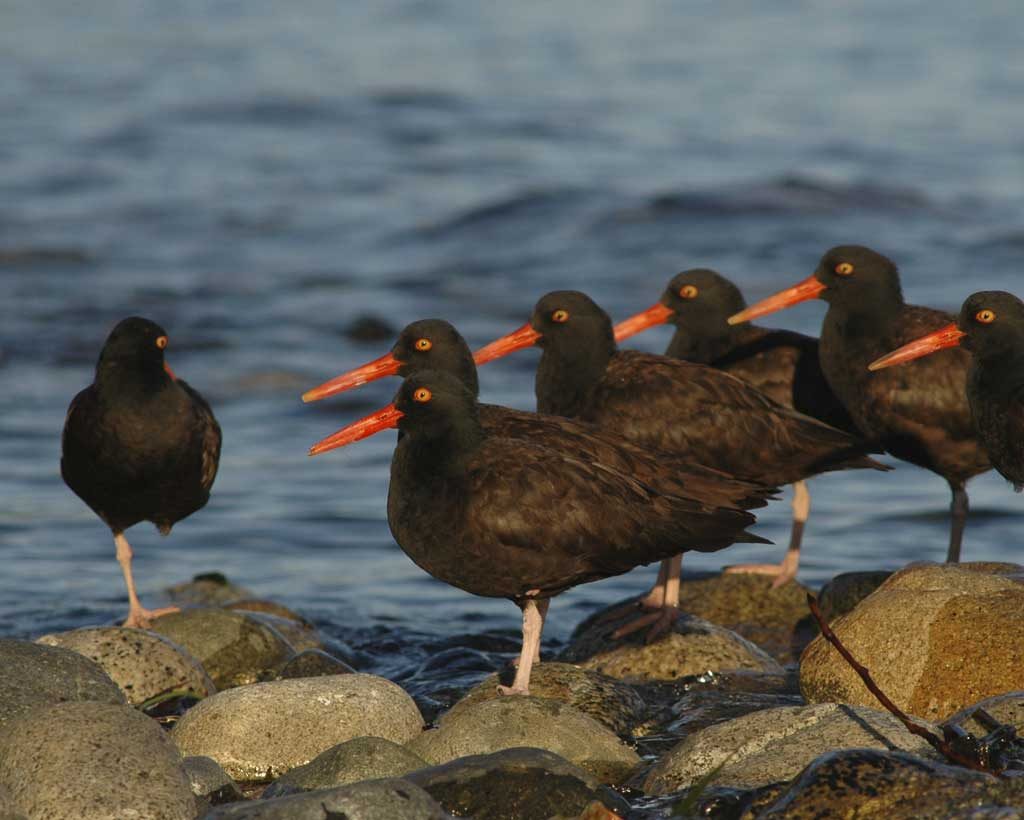
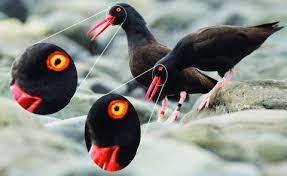
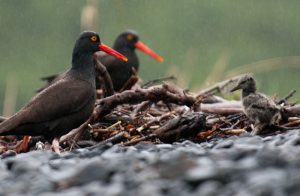
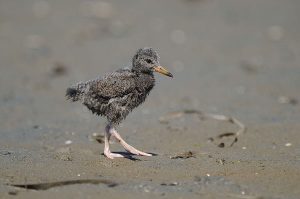
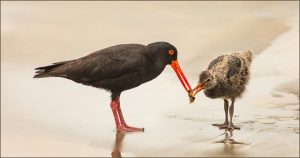
Hi Brian,
I loved this post! I have always been fond of oystercatchers, ever since I noticed their puffball chicks on a little island near Silva Bay. As you said, very adorable. I am also extremely stoked to learn that they used to be called sea-pies & I will most certainly be adding “a stew of sea-pies” to my vocabulary.
– Hannah